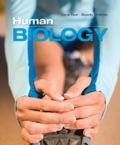
EBK HUMAN BIOLOGY
11th Edition
ISBN: 8220100545931
Author: MCMILLAN
Publisher: Cengage Learning US
expand_more
expand_more
format_list_bulleted
Textbook Question
Chapter 7, Problem 1RQ
List the functions of the cardiovascular system.
Expert Solution & Answer
Summary Introduction
To list: Functions of cardiovascular system.
Introduction: The cardiovascular system is also known as circulatory system. The cardiovascular system is composed of two components: heart and the blood vessels.
Explanation of Solution
The functions of cardiovascular system are as follows:
- • The general function of a cardiovascular system is to circulate the blood throughout the body to meet the requirements of body cells. The cells need a continuous delivery of nutrients and oxygen, and removal of carbon dioxide and other waste products to stay healthy. The heart is the most important organ of the circulatory system. It is a muscular organ that pumps the oxygenated blood to every part of the body. The three types of the blood vessels are arteries, veins, and capillaries.
- • It ensures the immune protection and confirms the appropriate functioning of the body as a unit.
Want to see more full solutions like this?
Subscribe now to access step-by-step solutions to millions of textbook problems written by subject matter experts!
Students have asked these similar questions
The following figure is from Caterina et al. The capsaicin receptor: a heat activated ion channel in the
pain pathway. Nature, 1997. Black boxes indicate capsaicin, white circles indicate resinferatoxin.
You are a chef in a fancy new science-themed restaurant. You have a recipe that calls for 1 teaspoon of resinferatoxin, but you feel uncomfortable serving foods with "toxins" in them. How much capsaicin could you substitute instead?
What protein is necessary for packaging acetylcholine into synaptic vesicles?
1. Match each vocabulary term to its best descriptor
A. affinity
B. efficacy
C. inert
D. mimic
E. how drugs move through body
F. how drugs bind
Kd
Bmax
Agonist
Antagonist
Pharmacokinetics
Pharmacodynamics
Chapter 7 Solutions
EBK HUMAN BIOLOGY
Ch. 7 - List the functions of the cardiovascular system.Ch. 7 - Define a heartbeat, giving the sequence of events...Ch. 7 - What is the difference between the systemic and...Ch. 7 - Prob. 4RQCh. 7 - Prob. 5RQCh. 7 - State the main functions of venules and veins....Ch. 7 - Label the hearts main parts in the diagram below.Ch. 7 - Cells obtain nutrients from and deposit waste into...Ch. 7 - The contraction phase of the heartbeat is ______;...Ch. 7 - Prob. 3SQ
Ch. 7 - In the systemic circuit, the hearts _______ half...Ch. 7 - After you eat, blood passing through the GI tract...Ch. 7 - Prob. 6SQCh. 7 - Prob. 7SQCh. 7 - Prob. 8SQCh. 7 - _____ contraction drives blood through the...Ch. 7 - Match the type of blood vessel with its major...Ch. 7 - Prob. 11SQCh. 7 - A patient suffering from hypertension may receive...Ch. 7 - Heavy smokers often develop abnormally high blood...Ch. 7 - Prob. 3CTCh. 7 - Several years ago the deaths of several airline...
Knowledge Booster
Learn more about
Need a deep-dive on the concept behind this application? Look no further. Learn more about this topic, biology and related others by exploring similar questions and additional content below.Similar questions
- 50 mg dose of a drug is given orally to a patient. The bioavailability of the drug is 0.2. What is the volume of distribution of the drug if the plasma concentration is 1 mg/L? Be sure to provide units.arrow_forwardDetermine Kd and Bmax from the following Scatchard plot. Make sure to include units.arrow_forwardChoose a catecholamine neurotransmitter and describe/draw the components of the synapse important for its signaling including synthesis, packaging into vesicles, receptors, transporters/degradative enzymes. Describe 2 drugs that can act on this system.arrow_forward
- The following figure is from Caterina et al. The capsaicin receptor: a heat activated ion channel in the pain pathway. Nature, 1997. Black boxes indicate capsaicin, white circles indicate resinferatoxin. a) Which has a higher potency? b) Which is has a higher efficacy? c) What is the approximate Kd of capsaicin in uM? (you can round to the nearest power of 10)arrow_forwardWhat is the rate-limiting-step for serotonin synthesis?arrow_forwardWhat enzyme is necessary for synthesis of all of the monoamines?arrow_forward
arrow_back_ios
SEE MORE QUESTIONS
arrow_forward_ios
Recommended textbooks for you
 Human Biology (MindTap Course List)BiologyISBN:9781305112100Author:Cecie Starr, Beverly McMillanPublisher:Cengage Learning
Human Biology (MindTap Course List)BiologyISBN:9781305112100Author:Cecie Starr, Beverly McMillanPublisher:Cengage Learning Biology (MindTap Course List)BiologyISBN:9781337392938Author:Eldra Solomon, Charles Martin, Diana W. Martin, Linda R. BergPublisher:Cengage Learning
Biology (MindTap Course List)BiologyISBN:9781337392938Author:Eldra Solomon, Charles Martin, Diana W. Martin, Linda R. BergPublisher:Cengage Learning Human Physiology: From Cells to Systems (MindTap ...BiologyISBN:9781285866932Author:Lauralee SherwoodPublisher:Cengage Learning
Human Physiology: From Cells to Systems (MindTap ...BiologyISBN:9781285866932Author:Lauralee SherwoodPublisher:Cengage Learning Concepts of BiologyBiologyISBN:9781938168116Author:Samantha Fowler, Rebecca Roush, James WisePublisher:OpenStax College
Concepts of BiologyBiologyISBN:9781938168116Author:Samantha Fowler, Rebecca Roush, James WisePublisher:OpenStax College

Human Biology (MindTap Course List)
Biology
ISBN:9781305112100
Author:Cecie Starr, Beverly McMillan
Publisher:Cengage Learning

Biology (MindTap Course List)
Biology
ISBN:9781337392938
Author:Eldra Solomon, Charles Martin, Diana W. Martin, Linda R. Berg
Publisher:Cengage Learning

Human Physiology: From Cells to Systems (MindTap ...
Biology
ISBN:9781285866932
Author:Lauralee Sherwood
Publisher:Cengage Learning



Concepts of Biology
Biology
ISBN:9781938168116
Author:Samantha Fowler, Rebecca Roush, James Wise
Publisher:OpenStax College
The Cardiovascular System: An Overview; Author: Strong Medicine;https://www.youtube.com/watch?v=Wu18mpI_62s;License: Standard youtube license